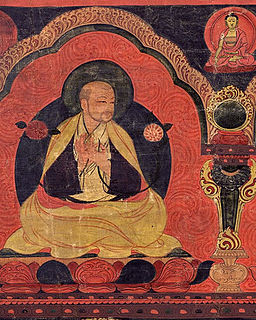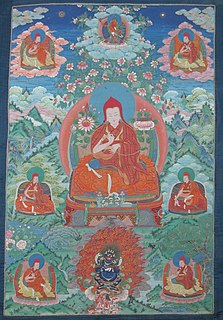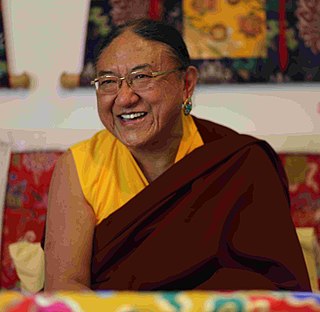
Drogön Chogyal Phagpa, was the fifth leader of the Sakya school of Tibetan Buddhism. He was also the first Imperial Preceptor of the Yuan dynasty, and was concurrently named the director of the Bureau of Buddhist and Tibetan Affairs, serving during the reign of Kublai Khan. Historical tradition remembers him as the first vice-ruler of Tibet under the Yuan emperor as well as one of the Five Sakya patriarchs. Although this is historically disputed, he played a very important political role.

Jamyang Khyentse Wangpo, also known by his tertön title, Pema Ösel Dongak Lingpa, was a renowned teacher, scholar and tertön of 19th-century Tibet. He was a leading figure in the Rimé movement.

Sachen Kunga Nyingpo (1092–1158) was a Tibetan spiritual leader and the first of the Five Venerable Supreme Sakya Masters of Tibet. Sachen Kunga Nyinpo was the 3rd Sakya Trizin and son of Khon Konchok Gyalpo (1034–1102) who was the first Sakya Trizin and founder of the first Sakya Monastery in Tibet in 1073.

Sonam Tsemo, an important Tibetan sprititual leader and Buddhist scholar, was the second of the so-called Five Venerable Supreme Sakya Masters of Tibet, the founding fathers of the Sakya tradition.

Sakya PanditaKunga Gyeltsen was a Tibetan spiritual leader and Buddhist scholar and the fourth of the Five Sakya Forefathers. Künga Gyeltsen is generally known simply as Sakya Pandita, a title given to him in recognition of his scholarly achievements and knowledge of Sanskrit. He is held in the tradition to have been an emanation of Manjusri, the embodiment of the wisdom of all the Buddhas.

Sakya Monastery, also known as Pel Sakya is a Buddhist monastery situated in Sa'gya Town (ས་སྐྱ་), Sa'gya County, about 127 km west of Shigatse in Tibet Autonomous Region.

Sakya Trizin is the traditional title of the head of the Sakya school of Tibetan Buddhism.
Lamdré is a meditative system in Tibetan Buddhism rooted in the view that the result of its practice is contained within the path. The name "lamdré" means the “path" with its fruit Wylie: ‘bras). In Tibet, the lamdré teachings are considered the summum bonum of the Sakya school.

Phagmo Drupa Dorje Gyalpo [1110-1170], was one of the three main disciples of Gampopa Sonam Rinchen who established the Dagpo Kagyu school of Tibetan Buddhism; and a disciple of Sachen Kunga Nyingpo [1092-1158] one of the founders of the Sakya school of Tibetan Buddhism. He was the elder brother of Kathog Dampa Deshek [1122-1192], who founded Kathog monastery and the Kathog branch of the Nyingma school.
Ngor is a sub-sect of the Sakya tradition of Tibetan Buddhism. The main monastery of the Ngor sect is the Ngor monastery of Evam Choden about 20 kilometres (12 mi) southwest of Xigazê.
Dharmapala Raksita was the head of the Sakya school of Tibetan Buddhism, which was the most powerful school in Tibet under the Yuan dynasty from 1280–82. He also held the title of Imperial Preceptor (Dishi), from 1282–86.
Jamyang Rinchen Gyeltsen, was the ruler of the Sakya school of Tibetan Buddhism, which had precedence in Tibet under the Yuan dynasty, in 1286-1303. He also held the title of Imperial Preceptor ( Dishi) from 1304 to his demise in 1305.
Zangpo Pal, in full Danyi Chenpo Zangpo Pal, was the ruler of Sakya, which held a precedence position in Tibet under the Yuan dynasty. He ruled nominally from 1298, in reality from 1306 to his death in 1323.
Rinchen Gyaltsen was a Tibetan imperial preceptor at the court of the Mongol-led Yuan dynasty of China. His tenure lasted from 1274 to his death in either 1279 or 1282.
Drakpa Odzer was a Tibetan Imperial Preceptor (Dishi) at the court of the Mongol-led Yuan dynasty of China. He hailed from Sakya which was the foremost monastic regime in Tibet in this period. He held the post from 1291 to his death in 1303.
The Imperial Preceptor, or Dishi was a high title and powerful post created by Kublai Khan, founder of the Yuan dynasty. It was established as part of Mongol patronage of Tibetan Buddhism and Yuan administrative rule of Tibet.
Khön Könchok Gyalpo was the founder of the Sakya School of Tibetan Buddhism, and the founder of Sakya Monastery. Khön Könchok Gyalpo was born in Sa'gya, Tsang. He was a member of the Khön family, and his ancestry can be traced back to Khön Dorje Rinpoche, student of Padmasambhava. He followed his father and brother and learned doctrines of the Nyingma School at a young age, but studied newly translated Vajrayāna texts with Drogmi Shakya Yeshe later. Khön Könchok Gyalpo established Sakya Monastery in 1073, where the Sakya Tradition first developed. His son Khön Kunga Nyingpo was regarded as the first leader of Sakya, and Khön Könchok Gyalpo is known as the first Sakya Trizin.

Sakya Trizin Ngawang Kunga served as the 41st Sakya Trizin, the throne holder of the Sakya Lineage of Tibetan Buddhism, from his appointment in 1952 until his retirement in 2017. His religious name is Ngawang Kunga Tegchen Palbar Trinley Samphel Wangyi Gyalpo. After passing the throne of the Sakya lineage to his elder son Ratna Vajra Rinpoche who became the 42nd Sakya Trizin on 9 March 2017, he is now known as Kyabgon Gongma Trichen Rinpoche. He is considered second only to the Dalai Lama, in the spiritual hierarchy of Tibetan Buddhism.
The Phagmo Drupa Kagyu or Phagdru Kagyu (ཕག་གྲུ་བཀའ་བརྒྱུད) is a subschool of the Tibetan Kagyu school.
Khön clan of Sakya is a Tibetan clan and nobility originally based in Sa'gya. The clan traces its history to the time of Bod Chen Po. The Sakya Trizin of Sakya school was exclusively chosen from members of this clan. The current head of Khön clan is Gyana Vajra Rinpoche.
















